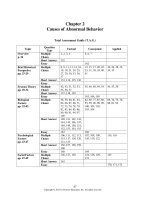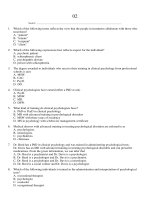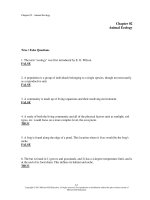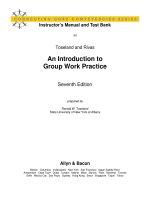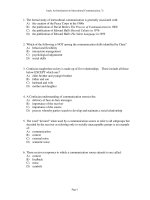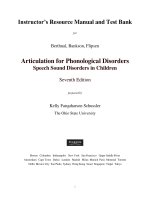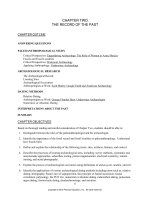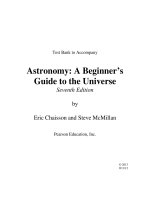Anthropology a global perspective 7th edition scupin test bank
Bạn đang xem bản rút gọn của tài liệu. Xem và tải ngay bản đầy đủ của tài liệu tại đây (321.06 KB, 8 trang )
CHAPTER TWO
THE RECORD OF THE PAST
CHAPTER OUTLINE
ANSWERING QUESTIONS
PALEOANTHROPOLOGICAL STUDY
Critical Perspectives: Engendering Archaeology: The Role of Women in Aztec Mexico
Fossils and Fossil Localities
Critical Perspectives: Historical Archaeology
Applying Anthropology: Underwater Archaeology
ARCHAEOLOGICAL RESEARCH
The Archaeological Record
Locating Sites
Archaeological Excavation
Anthropologists at Work: Scott Madry: Google Earth and American Archaeology
DATING METHODS
Relative Dating
Anthropologists at Work: George Fletcher Bass: Underwater Archaeologist
Numerical, or Absolute, Dating
INTERPRETATIONS ABOUT THE PAST
SUMMARY
CHAPTER OBJECTIVES
Based on thorough reading and careful consideration of Chapter Two, students should be able to:
1. Distinguish between the roles of the paleoanthropologist and the archaeologist.
2. Identify the importance of the fossil record and fossil localities to paleoanthropology. Understand
how fossils form.
3. Define and explain the relationship of the following terms: sites, artifacts, features, and context.
4. Describe the processes of locating archaeological sites, including: survey methods, systematic and
unsystematic approaches, subsurface testing, proton magnetometer, electrical resistivity, remote
sensing, and aerial photography.
5. Explain the process of archaeological excavation using definitions of datum point, midden, and tell.
6. Identify the applications of various archaeological dating methods including terms such as: relative
dating, stratigraphy, Steno's law of supraposition, the principle of faunal succession, faunal
correlation, palynology, the FUN trio, numerical or absolute dating, radiocarbon dating, potassiumargon dating, fission-track dating, dendrochronology, and seriation.
6
Copyright © 2012 Pearson Education, Inc. All rights reserved.
7. Explain some of the implications of biased versus balanced interpretations of the archaeological
record. Explain what information is hard to access through archaeology.
LECTURE AND DISCUSSION TOPICS
Each of these topics is intended to generate ideas for either a lecture/recitation format or discussion in the
classroom. For most topics, students should be able to respond and participate in discussions based solely
on reading the text. For others, you may need to provide further reading or other forms of information so
that students can develop some personal perspective and become equipped to make independent
decisions about the topics.
1. Lecture on the distinctions between the roles and activities of paleoanthropologists and
archaeologists, emphasizing the different methods, materials, and results in each area of study.
2. Lecture on the importance of the fossil record, how fossils form, the information that they yield, and
the difficulties inherent in the interpretation of the fossil record. Explain the concepts of fossil
localities and the processes of fossil collection.
3. Lecture on the basic concepts of archaeology. Explain the relationship of sites, artifacts, features,
context, and preservation. Include in your discussion an explanation of previous attempts at
studying the past, such as antiquaries' collections, with contemporary research designs, or
archaeological methods.
4. Lecture on the comparative contributions of different methodological approaches to studying the
past, including historical archaeology, ethnoarchaeology, the direct historical approach, and
underwater archaeology.
5. Lecture on the various processes of locating archaeological sites. Include in your discussion an
explanation of survey methods, systematic and unsystematic approaches to archaeological surveys.
Discuss the benefits and limitations of the methods for subsurface testing, including the proton
magnetometer and electrical resistivity. Explain the process of remote sensing using aerial
photography and satellites.
6. Lecture on the process of archaeological excavation, distinguishing the types of information that
excavation yields, and the expectations for the use of such information (for instance, the results of
an excavation of a midden or tell).
7. Lecture on the applications of various archaeological dating methods. Illustrate, with examples, the
distinction between relative dating and numerical, or absolute, dating using relevant terms, such as:
strata, Steno's law of supraposition, the principle of faunal succession, faunal correlation,
palynology, the FUN trio, radiocarbon dating, potassium-argon dating, fission-track dating,
dendrochronology, and seriation.
8. Lecture on the mechanics of radiocarbon dating and its value to anthropology and archaeology.
You could also discuss other forms of radioactive dating, such as the potassium-argon method. You
might also show the film The Tree That Put the Clock Back, which describes the relationship
between radiocarbon dating, dendrochronology, and the collapse of diffusionism. It cites Colin
Renfrew as a primary source.
7
Copyright © 2012 Pearson Education, Inc. All rights reserved.
9. Lecture on the implications of biased versus balanced interpretations of the archaeological record.
Use historical examples with which students may be familiar.
CLASSROOM ACTIVITIES
1. One very vivid way to illustrate the processes of archaeological methods is to have students
participate in a mock dig. Construct a "site" with various levels and artifacts, which may be used to
simulate the process of archaeological discovery of artifacts.
2. Invite professionals from other disciplines to guest lecture: a geologist to discuss stratigraphy, a
biologist on faunal succession/faunal correlation and palynology, a chemist on the FUN trio, and a
physicist on radioactive decay dating (e.g., potassium-argon dating, fission-track dating, and
Carbon-14 dating).
3. Students can debate the methods and merits of artifact and site preservation, based on outside
reading from news articles and current research. Also have students look at recent Internet
websites. Several examples are included under the Additional Resources section at the end of this
guide.
4. As an application activity, have students assume the role of a historical archaeologist, an
ethnoarchaeologist, or an underwater archaeologist. Ask them to explain the relative merits of each
of their methods to others in the group, to compare the difficulties and reliability of each of their
approaches to studying the past. Create scenarios or problems, which require their unique skills, or
require a combination of these methods to find a solution. Encourage students to find out what
archaeological experiences may be available in their community.
5. Simulate or use actual site maps to give students experience in the techniques involved with
locating archaeological sites. Viewing slides, aerial photographs, or diagrams of artifact scatters,
students could define where a site might be and indicate what methods might be used to test the site.
6. One way to encourage reflection on the implications of biased versus balanced interpretations of the
archaeological record, is to have students investigate some of the frauds that have been perpetrated
throughout history using archaeological "facts." Students might read about social, political, and
economic conditions, and theoretical perspectives that affected the interpretation of archaeological
investigations. Have them explain what the current perspective is on the interpretation of such
finds.
RESEARCH AND WRITING TOPICS (Research Navigator)
Encourage your students to utilize the free tool OneSearch with Research Navigator, included with this
textbook as a supplement. They will have to register to use this service. Once registered, students can use
this tool to research the Internet to find valid sources for research papers, saving them much time in their
efforts to identify relevant sources.
1. Research the roles of the paleoanthropologist and the archaeologist; report on the similarities and
differences of these two fields, using actual practitioners as examples.
2. Based on a mock excavation, students might write a report, including the need for site preservation,
modeled after actual site preservation documents.
8
Copyright © 2012 Pearson Education, Inc. All rights reserved.
3. Students might research eighteenth- and nineteenth-century accounts and records of antiquaries
collectors. Compare the collections and the intent of the collectors with those of researchers today
and of the current threat of damage to archaeological sites by pot hunting.
4. Research and write a comparative paper on the methods and contributions of each of the following
approaches to studying the past: historical archaeology, ethnoarchaeology, the direct historical
approach, and underwater archaeology.
5. Write a descriptive paper on the processes of locating archaeological sites, including an evaluation
of current practices in one or more of the following: survey methods, systematic and unsystematic
approaches, subsurface testing, proton magnetometer, electrical resistivity, remote sensing, and
aerial photography.
6. Write an evaluative paper on one or more of the applications of various archaeological dating
methods, such as: relative dating, strata, Steno's law of supraposition, the principle of faunal
succession, faunal correlation, palynology, the FUN trio, numerical or absolute dating, radiocarbon
dating, potassium-argon dating, fission-track dating, dendrochronology, and seriation. Compare
their benefits and drawbacks and their usefulness to archaeology and the study of human
development.
7. Evaluate various writers on the implications of biased versus balanced interpretations of the
archaeological record.
8. Write a website that operates like a time capsule. What sort of information would you include in it
so that people of the future could understand our generation, its problems, and its successes?
9. Evaluate some of the popular fictional literature that makes use of archaeology such as Tony
Hillerman's Westerns (Dance Hall of the Dead). Select one author and demonstrate how he or she
uses concepts of archaeology correctly or incorrectly.
10. Investigate what students and faculty do who participate in "garbology" studies at the University of
Arizona Department of Anthropology. Why would they do this?
PRINT RESOURCES
ALDENDERFER, MARK S. 1987. Quantitative Research in Archaeology: Progress and Prospects.
Newbury Park, CA: Sage Publications, Inc. A good book on formal and quantitative methods.
BEAUDRY, MARY C. 1988. Documentary Archaeology in the New World. New York: Cambridge
University Press. A fine collection of essays on the role of documents in historical archaeology.
BINFORD, LEWIS R. 1983. In Pursuit of the Past: Decoding the Archaeological Record. New York:
Thames and Hudson. An informative look at our archaeological past. A revealing account of
Binford's thinking.
BRAY, W., and D. TRUMP. 1973. The Penguin Dictionary of Archaeology. Baltimore: Penguin. A
good dictionary on the subject.
CARR, CHRISTOPHER. 1989. For Concordance in Archaeological Analysis: Bridging Data Structure,
Quantitative Technique and Theory. Prospect Heights, IL: Waveland Press. A fine series of papers
on theory.
9
Copyright © 2012 Pearson Education, Inc. All rights reserved.
COURBIN, PAUL. 1988. What Is Archaeology? An Essay on the Nature of Archaeological Research.
Chicago: University of Chicago Press. An interesting critique of the New Archaeology.
DANIEL, GLYN. 1981. A Short History of Archaeology. New York: Thames & Hudson. A brief
introduction to the history of archaeology by one of the leading scholars on the subject. This
volume concentrates on developments in Europe, Africa, and Asia and makes a nice contrast with
the Willey and Sabloff volume listed below.
DAVIS, SIMON J. M. 1987. The Archaeology of Animals. New Haven, CT: Yale University Press. A
fine introductory book on zooarchaeology.
DEETZ, JAMES. 1977. In Small Things Forgotten: The Archaeology of Early American Life. New
York: Anchor Books. A popular, highly readable overview of historical archaeology in the United
States by one of the leading scholars in the field. It discusses the sources of information and special
dating methods that can be used by archaeologists studying the recent past, as well as how
archaeologists have addressed specific research questions.
EDDY, FRANK W. 1991. Archaeology: A Cultural-Evolutionary Approach (2nd ed.). Englewood Cliffs,
NJ: Prentice Hall. An interesting work that takes an uncommon approach to archaeology.
EHRENBERG, MARGARET. 1989. Women in Prehistory. Norman: University of Oklahoma Press. A
good retelling of European prehistory to include women.
FAGAN, BRIAN. 1994. Quest for the Past: Great Discoveries in Archaeology, Revised edition.
Prospect Heights, IL: Waveland Press. An interesting look at some exciting discoveries in
archaeology.
2008. In the Beginning: An Introduction to Archaeology (12th ed.). New Jersey: Prentice Hall. A
very good introduction to general archaeology.
2003. Archaeologists: Explorers of the Human Past. Oxford University Press, USA.
2005. Ancient North America, 4th ed. Thames and Hudson.
GIBBON, GUY. 1984. Anthropological Archaeology. New York: Columbia University Press. An
interesting look at anthropological archaeology.
HODDER, IAN. 1986. Reading the Past: Current Approaches to Interpretation in Archaeology. New
York: Cambridge University Press. An insightful examination of post-processual archaeology.
HUME, IVOR NOEL. 1991. Martin's Hundred. University of Virginia Press. An excellent account of
how the Martin's Hundred way of life was reconstructed using historical archaeological techniques.
This book provides a view of life in Virginia during early colonization.
Also, a series of excellent monographs about Colonial Williamsburg for a popular audience:
Archaeology and the Colonial Gardener; Archaeology and Wetherburn's Tavern; Digging for Carter's
Grove; Discoveries in Martin's Hundred; Food, Glass in Colonial Williamsburg's Archaeological
Collections; James Geddy and Sons; Pottery and Porcelain in Colonial Williamsburg's
Archaeological Collections; and The Wells of Williamsburg: Colonial Time Capsules.
JOUKOWSKY, MARTHA. 1980. A Complete Manual of Field Archaeology. Englewood Cliffs, NJ:
Prentice Hall. An excellent field and lab manual.
10
Copyright © 2012 Pearson Education, Inc. All rights reserved.
KELLEY JANE H., and MARSHA P. HANEN. 1988. Archaeology and the Methodology of Science.
Albuquerque: University of New Mexico Press. A book that addresses the relationship between
archaeology and philosophy, between archaeological theory and archaeological practice.
KENT, SUSAN. 1984. Analyzing Activity Areas: An Ethnoarchaeological Study of the Use of Space.
Albuquerque: University of New Mexico Press. A pioneering work on this subject.
MacNEISH, RICHARD S. 1978. The Science of Archaeology? North Scituate, MA: Duxbury. A very
readable account of an individual archaeologist's look at things.
McINTOSH, JANE. 1986. The Practical Archaeologist: How We Know What We Know about the Past.
New York: Facts on File. A well-illustrated introduction to archaeology.
PRICE, DOUG, and GITTE GEBAUER. 1989. Adventures in Fugawiland. Mountain View, CA:
Mayfield. A good archaeological simulation (disk [IBM compatible] and workbook) that has a
regional focus.
PROTHERO, DONALD R. 1989. Interpreting the Stratigraphic Record. New York: W.H. Freeman.
An authoritative work on the principle, techniques, and methods used in dating and interpreting the
geological record.
RENFREW, COLIN, and PAUL BAHN. 2000. Archaeology: Theories, Methods, and Practice, 3rd ed.
New York: Thames and Hudson. An interesting inquiry into general archaeology from a problemoriented point of view.
RICE, PRUDENCE M. 1987. Pottery Analysis: A Sourcebook. Chicago: University of Chicago Press.
An excellent synthesis and reference text on pottery analysis.
SCHIFFER, MICHAEL B. 1987. Formation Processes of the Archaeological Record. Albuquerque:
University of New Mexico Press. A favorably-reviewed book on the process of archaeological site
formation.
1989. Archaeological Method and Theory. Tucson: University of Arizona Press. A good collection of
papers.
SCHUYLER, ROBERT L. 1978. Historical Archaeology: A Guide to Substantive and Theoretical
Contributions. Farmingdale, NY: Baywood Publishing Company. An excellent collection of
articles about historical archaeology.
SPENCER-WOOD, SUZANNE M. 1987. Consumer Choice in Historical Archaeology. New York:
Plenum Press. A novel collection of articles that recovers consumer choice of the past from the
archaeological record.
STEIBING, WILLIAM H. 1993. Uncovering the Past: A History of Archaeology. Oxford: Oxford
University Press.
THOMAS, DAVID H. 2005. Archaeology, 4th ed. Wadsworth Publishing. A good book on
archaeology.
THROCKMORTON, PETER, ed. 1987. The Sea Remembers: Shipwrecks and Archaeology from
Homer’s Greece to the Rediscovery of the Titanic. New York: Weidenfeld & Nicholson. A
compilation on nautical archaeology by one of the pioneers in the field. It provides an enjoyable,
broad survey of the variety of sites and discoveries that have been recovered from shipwreck sites.
11
Copyright © 2012 Pearson Education, Inc. All rights reserved.
TRIGGER, BRUCE G. 1989. A History of Archaeological Thought. Cambridge: Cambridge University
Press. This volume provides the best available synthesis of the history of archaeology in worldwide
perspective. The intellectual and social context in which archaeology emerged is also discussed.
UBELAKER, DOUGLAS H. 1989. Human Skeletal Remains: Excavation, Analysis, Interpretation, 2nd
ed. New York: Taraxacum. An interesting perspective.
WILLEY, GORDON R., AND JEREMY A. SABLOFF. 1993. A History of American Archaeology, 3rd
ed. New York: W.H. Freeman. A comprehensive and very readable overview of the origins and
development of American archaeology, beginning with the first descriptions of monuments by
European explorers to the present theoretical approaches.
ATLASES:
The Atlas of Archaeology. New York: St. Martin's Press, 1982.
Hammond Past Worlds: The Times Atlas of Archaeology. Maplewood, NJ: Hammond, 1988.
The World Atlas of Archaeology. New York: Portland House, 1988.
FILM, VIDEO, AND NONPRINT RESOURCES
(Color unless otherwise noted)
OMOHUNDRO, JOHN T., and KATHLEEN GOODMAN. 1990. Mystery Fossil: A Physical
Anthropology Laboratory Exercise for the Macintosh. Mountain View, CA: Mayfield. An excellent
computer simulation that has students evaluate fossil skulls and fit three mystery fossils into the
known material.
The Ancient Mariners (60 minutes) PBS Video, 800/424-7963
Archaeological Dating. Retracing Time (17 minutes) Penn State, 800/826-0132
Atom and Archaeology (24 minutes) Penn State, 800/826-0132
Ben's Mill (60 minutes) PBS Video, 800/424-7963
Body in the Bog (30 minutes) Penn State, 800/826-0132
Buried in Ice (57 minutes) Penn State, 800/826-0132
Dating the Past (29 minutes) (B&W) Penn State, 800/826-0132
Five Foot Square (30 minutes) University of California, 415/642-0460
4-Butte-1: A Lesson in Archaeology (33 minutes) Penn State, 800/826-0132
Hedeby: The Salvage of a Viking Ship (42 minutes) Penn State, 800/826-0132
Other People's Garbage (59 minutes) Penn State, 800/826-0132
Place in Time (28 minutes) Penn State, 800/826-0132
Rock Engravings (7 minutes) Penn State, 800/826-0132
INTERNET EXERCISES
1. Refer to the Critical Perspectives box titled “Engendering Archaeology: The Role of Women in
Aztec Mexico.” After surveying the following website, />how do you think the conference ties to this box? What is the significance of “A Landscape of
Ancestors: The Heuneburg Archaeological Project” found at
/>2. The website discusses the focus of historical
12
Copyright © 2012 Pearson Education, Inc. All rights reserved.
archaeology. What is it? How does this compare to the Critical Perspectives box titled “Historical
Archaeology"? What is the overall value of historical archaeology compared to history?
3. Underwater archaeology, as exemplified in the Applying Anthropology box titled the same, is a
rather unique field. By looking at the two related websites, and
list the requirements for becoming an underwater
archaeologist. What personality traits might be important for this type of work? What are the
rewards of underwater archaeology?
4. Review the Anthropologists at Work box titled: “George Fletcher Bass: Underwater Archaeologist.”
Compare this to the following websites: and
What
type of background does an underwater archaeologist need? What types of training does it take to
work in the discipline of underwater archaeology?
5. />This site provides a number of hotlinks to other interesting archaeological sites as well as copious
information on regional archaeology and access to archaeological data. One feature of this site is a
list of museums around the world that have New World archaeology, Old World archaeology, or
exhibits on culture.
13
Copyright © 2012 Pearson Education, Inc. All rights reserved.
